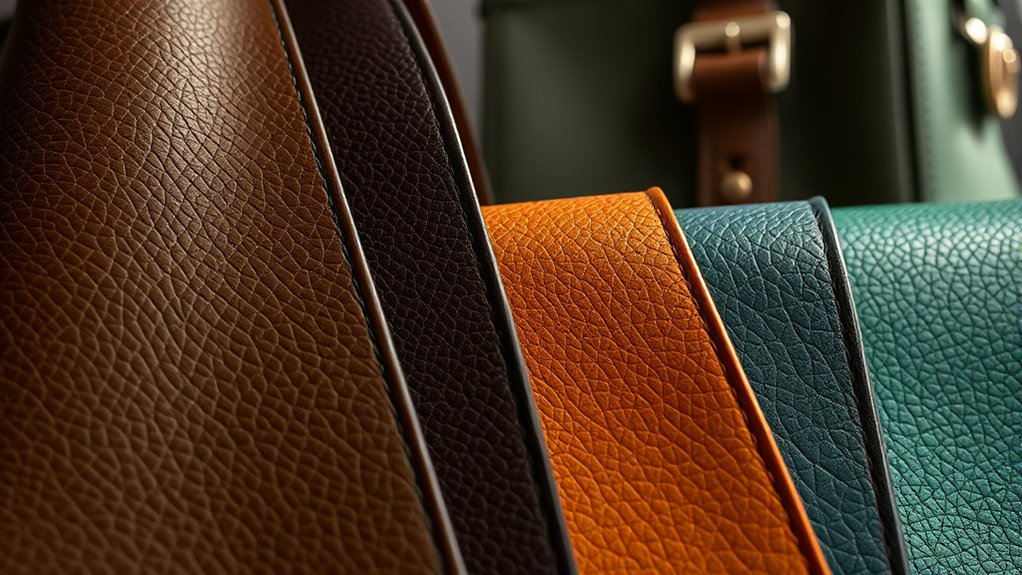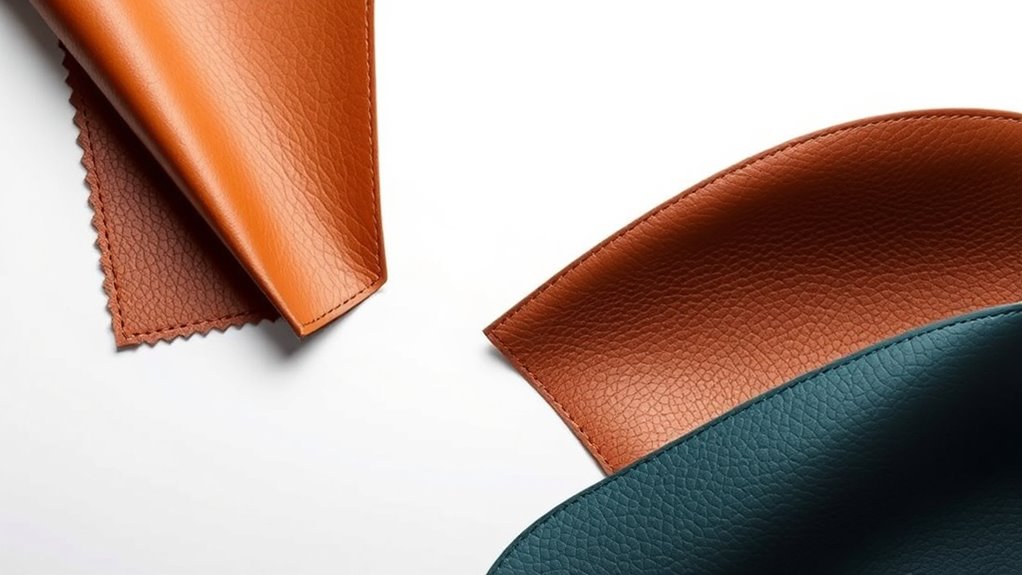Vegan leather innovations are revolutionizing the bag industry by offering sustainable, cruelty-free materials made from plant-based and recycled sources like apple peels, cork, pineapple leaves, and mushroom mycelium. These materials are durable, stylish, and eco-friendly, reducing water and energy use while supporting animal welfare. As these technologies improve, they’re expected to rival traditional leather in quality. Stay tuned to discover how these eco-conscious options are transforming the future of fashion.
Key Takeaways
- Innovative vegan leathers utilize plant-based and recycled materials like apple peels, cork, pineapple leaves, and mushroom mycelium, reducing waste and environmental impact.
- These materials often require less water, energy, and chemicals compared to traditional leather, enhancing sustainability.
- Mushroom and fruit-based leathers offer durable, stylish alternatives that match or surpass traditional leather in aesthetics and longevity.
- Ethical benefits include cruelty-free production, eliminating animal exploitation and supporting humane fashion choices.
- Industry trends show a shift towards responsible manufacturing, integrating eco-friendly, innovative materials to meet consumer demand for sustainable products.

Have you ever wondered if vegan leather can truly match the qualities of traditional leather? It’s a common question as the bag industry seeks more ethical and eco-friendly options. Today’s vegan leathers aren’t just about replacing animal products; they’re about innovating with sustainable manufacturing processes that reduce environmental impact. Many brands are shifting towards materials that are created from plant-based or recycled sources, which require less water, energy, and chemicals compared to conventional leather production. This shift not only aligns with growing consumer demand for eco-conscious products but also addresses animal rights considerations. Vegan leather eliminates the need for animal farming and slaughter, which are often associated with ethical concerns about animal cruelty and exploitation. By choosing these alternatives, you’re supporting a more humane approach to fashion, one that respects animal lives and fosters compassionate choices.
The advancements in vegan leather materials show a clear move toward sustainability. Manufacturers are experimenting with a variety of innovative substances, such as apple peels, cork, pineapple leaves, and mushroom mycelium. These materials are often sourced as byproducts or renewable resources, making the entire manufacturing process more eco-friendly. For example, apple leather uses waste from the juice industry, reducing waste while creating a durable, stylish material. Similarly, mushroom-based leathers are grown in controlled environments that consume markedly less water and emit fewer greenhouse gases than traditional leather tanning. These innovations demonstrate how sustainable manufacturing is at the core of new vegan leather products, helping you reduce your carbon footprint without sacrificing quality or style. Additionally, some vegan leathers are inspired by distinctive dog breeds, emphasizing unique textures and aesthetics that appeal to diverse consumer preferences.
Animal rights considerations are a key factor driving the growth of vegan leather innovations. More consumers are aware of the ethical implications of their fashion choices, prompting brands to develop cruelty-free alternatives that don’t involve harming animals. When you opt for vegan leather, you’re actively participating in a movement that prioritizes animal welfare. Unlike traditional leather, which involves raising and slaughtering animals, vegan options are crafted without animal suffering. This shift not only addresses moral concerns but also appeals to those who want to make more conscious, ethical decisions in their everyday lives. As these materials improve in durability and aesthetics, it becomes easier to replace traditional leather with vegan alternatives that match or even exceed the qualities you expect, all while supporting the ethical treatment of animals and promoting sustainable manufacturing practices.
In the end, vegan leather innovations reflect a broader shift toward more responsible fashion. They’re driven by advances in sustainable manufacturing techniques and a genuine commitment to animal rights considerations. By choosing these materials, you’re part of a movement that values environmental health and animal welfare equally. The future of the bag industry is increasingly hinged on these eco-friendly, cruelty-free options, which prove that style, ethics, and sustainability can coexist beautifully.
Frequently Asked Questions
What Are the Environmental Impacts of Vegan Leather Production?
Vegan leather production impacts the environment by reducing reliance on animal farming, which supports sustainable farming practices. However, it can cause chemical pollution due to the use of synthetic processes and chemicals in manufacturing. You might find that some vegan leathers are more eco-friendly than traditional leather, but it’s essential to take into account the chemicals involved and whether the materials are sourced sustainably. Balancing innovation with environmental impact remains key.
How Durable Is Vegan Leather Compared to Traditional Leather?
Vegan leather often offers good synthetic durability, making it a solid choice for everyday use. Its material longevity can match traditional leather, especially with advancements in innovative materials. While it may not develop a rich patina over time like genuine leather, high-quality vegan options resist scratches and water better, ensuring your bag stays looking fresh longer. Overall, vegan leather provides a durable alternative that holds up well with proper care.
Are Vegan Leather Options Cost-Effective for Manufacturers?
You might find vegan leather options cost-effective for manufacturers since the cost comparison often favors them due to lower manufacturing costs. While initial investments can be higher, they save money in the long run, making it a win-win. Don’t let the price tag fool you—these materials are changing the game, proving that sustainable choices can also be budget-friendly without sacrificing quality or style.
Can Vegan Leather Be Recycled or Reused Easily?
You can recycle or reuse vegan leather, but recycling challenges remain due to its complex materials. Many types aren’t easily processed in standard recycling facilities, limiting reuse potential. However, some innovative options are developing biodegradable or more recyclable vegan leathers, increasing their reuse potential. As a user or manufacturer, you should stay informed about these advancements to better support sustainability and reduce waste in the industry.
What Are Consumer Perceptions of Vegan Leather Quality?
Imagine holding a polished gemstone—your trust in vegan leather’s quality hinges on its shine. Many consumers see it as promising but still seek reassurance, as their quality expectations vary. You might notice some perceive vegan leather as durable and eco-friendly, boosting their trust, while others worry about longevity. Overall, your perception depends on how well brands meet your standards for authenticity, craftsmanship, and consistency in quality.
Conclusion
As you explore the future of fashion, these vegan leather innovations could transform your wardrobe. Imagine choosing a stylish bag made from mushroom-based leather that’s eco-friendly and durable. By supporting these sustainable materials, you help reduce environmental impact and push the industry toward greener practices. So, next time you shop, consider the innovative options available—your choices can make a real difference in shaping a more sustainable and fashionable world.








